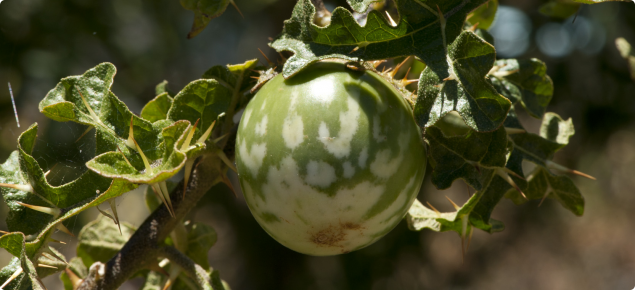Form: shrub — perennial
Status: present in WA
Appearance
Native of South Africa. In Western Australia it has mainly been found on coastal limestone soils from Yanchep to Mandurah and around Busselton and Augusta. It is also occasionally seen further inland.
Apple of Sodom is an erect branching woody shrub. It usually grows about one to two metres high, but occasionally reaches five metres. The plant forms dense thickets which provide cover for rabbits and shade out pasture plants. The thickets also restrict the movement of farm animals and machinery.
Stems: green-purple to brown with one centimetre long, curved straw-coloured spines.
Leaves: long leaves with deep irregular lobes. They are up to 15 centimetres long with long curved spines on both surfaces of the leaf. These are arranged along the veins and leaf stalk. Both stems and leaves are covered with minute star-shaped hairs.
Flowers: appear in spring and summer. They are about two centimetres across, and usually purple (occasionally white) with a yellow centre. Flowers have five petals joined to form a star.
Fruits: round, tomato-like fruit, green and white at first, turning yellow, then brown and black as it ripens. The fruit is about 30 millimetres in diameter. It contains numerous round flattened light brown seeds each about three millimetres across.
Seeds: most of the seed germinates in spring and late summer. Some seed may remain dormant in the soil for several years. Germination is greatly increased when the adult plant is removed.
Online weed identification training
Login or set up a new account on DPIRDs online training site to access:
- a training course on how to identify apple of Sodom and report it.
- training material that you can use to teach community groups how to identify apple of Sodom.
Agricultural and economic impact
Apple of Sodom can form dense patches in pastures, crowding out useful plants, restricting stock movement and harbouring pests such as rabbits and snails.
Declared pest category
The Western Australian Organism List (WAOL) contains information on the area(s) in which this pest is declared and the control and keeping categories to which it has been assigned in Western Australia (WA). Search for apple of Sodom in the WAOL using the scientific name of Solanum linnaeanum.
Requirements for land owners/occupiers and other persons
Requirements for land owners/occupiers and other persons if this pest is found can be sourced through the declared plant requirements link.
Search > detect > report
| MyPestGuide™ Reporter | Pest and Disease Information Service (PaDIS) |
Detectability: easy to find. Apple of Sodom is a large prickly shrub to 1.5 metres high and two metres wide. Given its size and bright yellow tomato-like fruits, it is very conspicuous and unlikely to be confused with other species in the South West Land Division.
Who is likely to find it: apple of Sodom could potentially be found by anyone in the South West Land Division, particularly in coastal areas from Perth to Bunbury, it is also reported to be spreading in the Ravensthorpe-Hopetoun region.
When to find it: apple of Sodom could potentially be found at any time of year in the South West Land Division.
Where to find it: apple of Sodom prefers calcareous sands but is not confined to them. It could be in a pasture (particularly if over-grazed), on roadsides, waste land or other disturbed soils. It is sometimes found where roadworks have been carried out and limestone used as part of the roadbase.
Control method
Control methods for this declared plant can be found through the apple of Sodom control link.





